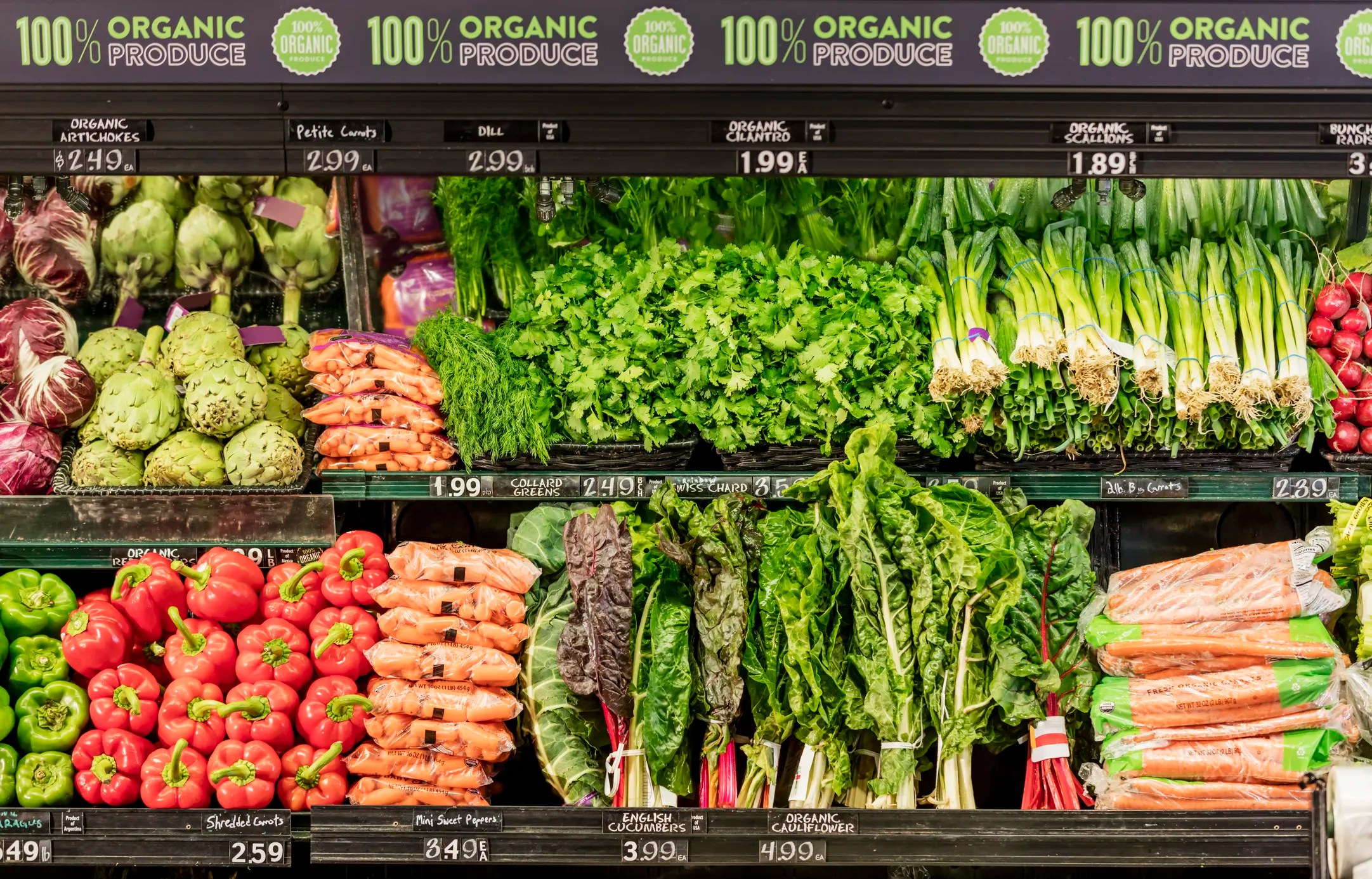What Does the “Organic” Label Mean?

Popular claims on products today include “clean,” “natural,” “regenerative,” “free-range,” “sustainably harvested,” and “green.” None of these claims are federally regulated—but “organic” is. All products labeled “organic” in the United States must meet the requirements of the USDA National Organic Program (NOP). As a consumer, understanding what the label “organic” actually means is helpful to make informed choices when purchasing products at the grocery store or farmers’ market.
What Does the USDA Organic Label Mean?
USDA organic is a label that indicates that food or agricultural products have been produced in accordance with the USDA’s National Organic Program (NOP) standards. The NOP develops and enforces these standards, which include the following:
- No prohibited substances: No genetically modified organisms (GMOs), sewage sludge, or ionizing radiation
- Organic ingredients: At least 95% of ingredients are certified organic for products labeled “organic”
- Organic farming practices: Use of natural fertilizers, crop rotation, and compost
- Pest management: Use of physical, mechanical, and biological controls, and a limited number of synthetic pesticides
- Animal welfare: Meat, dairy, and eggs come from animals that roam freely outdoors and are not given growth hormones or antibiotics
- Packaging: No artificial colors, flavors, or preservatives
These standards describe specific requirements that must be verified by a USDA-accredited certifying agent before products can be labeled as USDA organic.
Standards that Can Help in Agriculture and Food Production
Standards provide definitions for terminology as well as guidelines for how to best improve product quality and consistency. Adhering to standards is a helpful tool for handling ingredients, farming practices, labeling pesticides, food safety, animal welfare, and more. Here are various international standards that can be useful:
- ISO 21570 outlines the methods for analyzing and detecting GMOs in foodstuffs, primarily using quantitative nucleic acid-based methods like polymerase chain reaction (PCR) to quantify the relative GMO-derived DNA content.
- ISO/TS 19657 defines and specifies technical criteria for food ingredients to be considered natural and is only applicable in business-to-business communication (B2B).
- ISO 33407 provides guidance for producing pure organic substance certified reference materials, which is helpful for food testing.
- ISO 22002-1 specifies requirements for establishing, implement and maintaining prerequisite programs (PRPs) to assist in controlling food safety hazards in the food manufacturing process of the food supply chain.
- ISO 257 gives principles for creating common names for pesticides and other agrochemicals.
- ISO/TS 34700 provides requirements and guidance for the implementation of the animal welfare principles. It applies to terrestrial animals bred or kept for the production of food or feed.
Organic Product Labels
Labels containing the word “organic” are based on the percentage of organic ingredients in the product.
“100% Organic”
Products labeled as “100% organic” must contain only organically produced ingredients and processing aids, excluding water and salt. No other ingredients or additives are permitted.
“Organic”
Products labeled “organic” must contain at least 95% organically produced ingredients (excluding water and salt). Any remaining ingredients must consist of non-agricultural substances that appear on the NOP National List of Allowed and Prohibited Substances.
“Made with Organic_____”
Processed products that contain at least 70% organic ingredients may state “made with organic (insert up to three ingredients, food groups, or combination of ingredient and food groups)” on the principal display panel. A soup, for example, made with at least 70% organic ingredients and only organic vegetables may claim “soup made with organic peas, potatoes, and carrots” or “soup made with organic vegetables.” Organic ingredients must be identified on the information panel (e.g., “organic carrots”) or via an asterisk or other mark.
Processed products containing less than 70% organic ingredients cannot use the term “organic” anywhere on the principal display panel, but they can identify specific ingredients that are organically produced on the ingredients statement on the information panel.

Certified Organic Label
Certified organic means that a product has been grown and processed according to the USDA’s organic standards. The certification process includes various steps:
- The producer or developer creates an organic system plan
- A certifying agent reviews the plan and assures organic products meet all organic standards
- Inspections of farm fields and processing facilities are conducted by a certifying agent
- The certifying agent reviews the inspection report, which includes observations of practices on the farm or facility
- If an operation complies with the rules, the certifying agent issues an organic certificate listing products that can be sold as organic from that operation
To assure integrity of the USDA organic label, the certification system is rigorous. Nonetheless, thousands of producers and handlers continue to invest in these activities to market their products as organic.
Benefits of the Certified Organic Label
A “Certified Organic” label signifies that a product is grown and processed using methods that prioritize environmental sustainability, limit synthetic chemicals and GMOs, and promote biodiversity. This label thereby offers potential benefits, including reduced pesticide exposure, improved soil health, and a positive impact on the ecosystem. Essentially, a “Certified Organic” provides transparency and assurance that the product meets rigorous standards verified by a third-party certification process.
In addition to complying with the USDA’s National Organic Program (NOP) standards, an organization can adhere to international standards. ISO 9001 provides a foundational framework for quality control that can be applied to food safety practices; ISO 22000 helps any organizations in the food chain identify and control food safety hazards.






